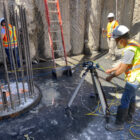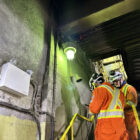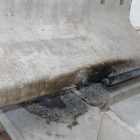Quality control of Concrete Caissons is a challenging task. Engineers, and contractors rely on experience and well-established procedures and test standards to verify the strength, and consistency of pile materials. Non-destructive testing help reveal potential defects that might have happened during pile casting (in the case of cast-in-place piles), or transportation and installation (in the case of precast piles).
Why We Need Quality Control for Concrete Caissons?
Certain errors in the construction and installation of concrete caissons might lead to defects in concrete pile. These defects can affect the durability performance of the pile, as well as mechanical properties, such as load bearing capacity. Poor patches of concrete, and honeycombed concrete can affect the durability and strength of concrete piles. Moreover, inconsistencies in pile cross-sectional shape (necking, bulging) are among integrity problems of concrete piles. Cracks, and discontinuities that might happen during installation can also affect the strength, and capacity of piles. Learn more about the Integrity Issues in Deep Foundations

Quality Control of Concrete Caissons
Different methods have been developed to evaluate the quality of concrete caissons. Apart from general concrete tests (concrete cylinder samples, and slump test), different non-destructive testing (NDT) methods can be used to evaluate the quality and reliability of concrete piles. These test can help identify and quantify integrity and quality related issues. The following NDT methods are widely accepted and used for evaluating the integrity of piles:
-
-
- Low Strain Impact Integrity Testing,
- Ultrasonic Cross Hole Testing for piles with accessible tip,
- Thermal Integrity Profiling,
- Parallel Seismic (ACI 228.2R) for piles covered up by pile-cap
-
1- Low Strain Impact Integrity Testing
Low strain impact integrity testing can be used to assess the integrity and consistency of piles. The test works best on relatively long piles, driven piles, augered piles, or drilled shafts. A hand-held hammer is used to impact the pile head. A Motion transducer is placed over the pile head and records the reflected echoes from the pile. The acceleration/velocity data are analyzed to identify potential defects in the pile. Pile integrity testing is standardized as ASTM D5882.

Applications: The test results can be used to evaluate pile cross-sectional area and length; determining the integrity and continuity of piles; and assess the consistency of pile materials.
Practical Considerations: The test does not provide any information on the load bearing capacity of piles. The test cannot be conducted over pile caps. and the test should be done by a competent engineer/technician.
Learn More About Low Strain Integrity Test
2- Ultrasonic Crosshole Testing
Ultrasonic Crosshole Testing provides information about the homogeneity and integrity of concrete. The method can be used for quality control of concrete piles. This method overcomes the limitation of low strain impact integrity testing. vertical holes are created using tubes at the time of pile construction (at least two). The tubes are filled with water. An acoustic wave emitter transducer is lowered to the bottom of one tube; while another acoustic wave receiving transducer is placed at the bottom of second tube. Both transducers are pulled upward at the same rate. The signals are analyzed and integrity profile of the pile is developed. an ultrasonic profile. The test procedure is standardized as ASTM D6760

Applications: Cross-hole testing can be used to determine the location of defects, as well as identifying the extent of the defects. The test can be done on larger diameter piles.
Practical Considerations: Requires installation of tubes during pile construction. Data recording and analysis might be expensive. Access to the tip of the wall is needed for most applications.
Learn More About Crosshole Sonic Logging
3- Thermal Integrity Profiling (TIP)
Thermal integrity profiling uses the temperature variation of cement paste concrete for integrity evaluation of piles and deep foundations. This method covers a wide range of piles and deep foundations including drilled shafts, bored piles, micro-piles, augured cast-in-place piles, continuous flight augured piles, drilled displacement piles, and more. The concept behind this technology is to record temperature changes and history during the curing time of cement. This temperature can be correlated to the strength gain of concrete and the integrity of piles and deep foundations.
Advantages:
-
-
- Thermal Integrity Profiling can be used to evaluate the portion of concrete outside the steel cage.
- Thermal Integrity Profiling provides real-time data on pile quality, which can shorten the construction timeline.
- Data interpretation is relatively easy.
-
Limitations:
-
-
- Thermal Integrity Profiling can only be used for integrity testing of new piles.
- Thermal Integrity Profiling requires a reference graph for comparing recorded logs for integrity evaluation.
- TIP wires and sensors may be damaged during installation and concrete placement.
- TIP measurement is a comparative method for integrity evaluation. Change in mix design may result in a huge difference when compared to the reference graph even though the concrete pile is sound.
-
4- Parallel Seismic Testing
The parallel Seismic method is mostly developed for integrity evaluation and quality control of concrete piles in existing structures, as the superstructure has been built upon the foundation. For integrity evaluation, a borehole is drilled close and parallel to the pile. Boreholes are lined with a plastic tube and filled by water for coupling between transducer and surrounding surface. An acoustic wave receiver is placed at the bottom of tube, moving upward with a constant speed. The pile-cap is struck by a hand-held hammer. The signals from the receiver probe and the depth-measuring device are recorded and analyzed the form of an acoustic wave profile. The profile is then used to evaluate the integrity of piles. The test method has been described in the ACI 228.2R document.
Applications: The test provides a practical solution in quality control of concrete piles when pile head is not accessible.
Limitations: Apart from being considered a more expensive NDT procedure, the test procedure requires drilling bore holes next to existing pile. This is not always possible in the vicinity of existing structure.





